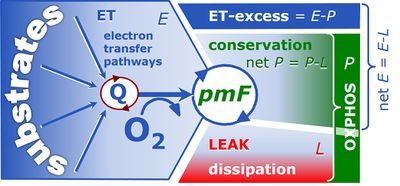Difference between revisions of "Coupling-control ratio"
| Line 1: | Line 1: | ||
{{MitoPedia | {{MitoPedia | ||
|abbr=''CCR'' | |abbr=''CCR'' | ||
|description='''Coupling-control ratios''', ''CCR'', are [[flux control ratio]]s, ''FCR'', at a constant mitochondrial [[pathway-control state]]. In mitochondrial preparations, there are three well-defined coupling states of respiration | |description='''Coupling-control ratios''', ''CCR'', are [[flux control ratio]]s, ''FCR'', at a constant mitochondrial [[pathway-control state]]. In mitochondrial preparations, there are three well-defined coupling states of respiration: [[LEAK]], [[OXPHOS]], and [[Electron transfer pathway |Electron transfer pathway state]] (ET state). In these states, the corresponding respirtory rates are symbolized as ''L'', ''P'', and ''E''. In living cells, the OXPHOS state cannot be induced, but in the [[ROUTINE]] state the respiration rate is ''R''. A reference rate ''J''<sub>ref</sub> is defined by taking ''J''<sub>ref</sub> as the maximum flux, i.e. flux in the ET state, ''E'', such that the lower and upper limits of the ''CCR'' are defined as 0.0 and 1.0. Then there are two mitochondrial ''CCR'', [[L/E |''L/E'']] and [[P/E |''P/E'']], and two ''CCR'' for living cells, [[L/E |''L/E'']] and [[ROUTINE-control ratio |''R/E'']]. | ||
|info=[[Flux control ratio]] | |info=[[Flux control ratio]] | ||
}} | }} | ||
| Line 7: | Line 7: | ||
== Coupling-control ratios related to free capacities == | == Coupling-control ratios related to free capacities == | ||
:::* [[L/P coupling control ratio |''L/P'' coupling control ratio]], ''L/P'' | :::* [[L/P coupling control ratio |''L/P'' coupling control ratio]], ''L/P'' | ||
:::: [[Free OXPHOS capacity]], '' | :::: [[Free OXPHOS capacity]], ''P-L'' | ||
:::: [[OXPHOS-coupling efficiency]], | :::: [[OXPHOS-coupling efficiency]], 1-''L/P'' | ||
:::* [[L/R coupling control ratio |''L/R'' coupling control ratio]], ''L/R'' | :::* [[L/R coupling control ratio |''L/R'' coupling control ratio]], ''L/R'' | ||
:::: [[Free ROUTINE activity]], '' | :::: [[Free ROUTINE activity]], ''R-L'' | ||
:::: [[ROUTINE coupling efficiency]], | :::: [[ROUTINE coupling efficiency]], 1-''L/R'' | ||
:::* [[LEAK-control ratio]], ''L/E'' | :::* [[LEAK-control ratio]], ''L/E'' | ||
:::: [[Free ET capacity]], '' | :::: [[Free ET capacity]], ''E-L'' | ||
:::: [[ET-coupling efficiency]], | :::: [[ET-coupling efficiency]], 1-''L/E'' | ||
:::* [[netOXPHOS-control ratio]], | :::* [[netOXPHOS-control ratio]], (''P-L'')/''E'' | ||
:::: [[Free OXPHOS capacity]], '' | :::: [[Free OXPHOS capacity]], ''P-L'' | ||
:::* [[NetROUTINE control ratio]], | :::* [[NetROUTINE control ratio]], (''R-L'')/''E'' | ||
:::: [[Free ROUTINE activity]], '' | :::: [[Free ROUTINE activity]], ''R-L'' | ||
:::* ''More details'' » [[ET-coupling efficiency]] | :::* ''More details'' » [[ET-coupling efficiency]] | ||
| Line 24: | Line 24: | ||
== Coupling-control ratios related to excess capacities == | == Coupling-control ratios related to excess capacities == | ||
:::* [[OXPHOS-control ratio]], ''P/E'' | :::* [[OXPHOS-control ratio]], ''P/E'' | ||
:::: [[Excess E-P capacity |Excess ''E-P'' capacity]], '' | :::: [[Excess E-P capacity |Excess ''E-P'' capacity]], ''E-P'' | ||
:::: [[Excess E-P capacity factor |Excess ''E-P'' capacity factor]], '' | :::: [[Excess E-P capacity factor |Excess ''E-P'' capacity factor]], ''1-''P/E'' | ||
:::* [[ROUTINE-control ratio]], ''R/E'' | :::* [[ROUTINE-control ratio]], ''R/E'' | ||
:::: [[Excess E-R capacity |Excess ''E-R'' capacity]], '' | :::: [[Excess E-R capacity |Excess ''E-R'' capacity]], ''E-R'' | ||
:::: [[Excess E-R capacity factor |Excess ''E-R'' capacity factor]], | :::: [[Excess E-R capacity factor |Excess ''E-R'' capacity factor]], 1-''R/E'' | ||
Revision as of 10:11, 13 October 2020
Description
Coupling-control ratios, CCR, are flux control ratios, FCR, at a constant mitochondrial pathway-control state. In mitochondrial preparations, there are three well-defined coupling states of respiration: LEAK, OXPHOS, and Electron transfer pathway state (ET state). In these states, the corresponding respirtory rates are symbolized as L, P, and E. In living cells, the OXPHOS state cannot be induced, but in the ROUTINE state the respiration rate is R. A reference rate Jref is defined by taking Jref as the maximum flux, i.e. flux in the ET state, E, such that the lower and upper limits of the CCR are defined as 0.0 and 1.0. Then there are two mitochondrial CCR, L/E and P/E, and two CCR for living cells, L/E and R/E.
Abbreviation: CCR
Reference: Flux control ratio

-
- Free OXPHOS capacity, P-L
- OXPHOS-coupling efficiency, 1-L/P
- Free ROUTINE activity, R-L
- ROUTINE coupling efficiency, 1-L/R
- LEAK-control ratio, L/E
- Free ET capacity, E-L
- ET-coupling efficiency, 1-L/E
- netOXPHOS-control ratio, (P-L)/E
- Free OXPHOS capacity, P-L
- NetROUTINE control ratio, (R-L)/E
-
- More details » ET-coupling efficiency
- OXPHOS-control ratio, P/E
- Excess E-P capacity, E-P
- Excess E-P capacity factor, 1-P/E
- Excess E-R capacity, E-R
- Excess E-R capacity factor, 1-R/E
Compare
- » Coupling control factor, CCF = 1-CCR
- » Respiratory acceptor control ratio, RCR
References
| Bioblast link | Reference | Year |
|---|---|---|
| Gnaiger 2020 BEC MitoPathways | Gnaiger E (2020) Mitochondrial pathways and respiratory control. An introduction to OXPHOS analysis. 5th ed. Bioenerg Commun 2020.2. https://doi.org/10.26124/bec:2020-0002 | 2020 |
| BEC 2020.1 doi10.26124bec2020-0001.v1 | Gnaiger E et al ― MitoEAGLE Task Group (2020) Mitochondrial physiology. Bioenerg Commun 2020.1. https://doi.org/10.26124/bec:2020-0001.v1 | 2020 |
- Bioblast links: Normalization - >>>>>>> - Click on [Expand] or [Collapse] - >>>>>>>
- Quantities for normalization
- » Count in contrast to Number
- » Mitochondrial marker
- » O2k-Protocols: mitochondrial and marker-enzymes
- » Citrate synthase activity
- Quantities for normalization
- General
- Related keyword lists
MitoPedia concepts:
Respiratory control ratio
MitoPedia methods:
Respirometry
